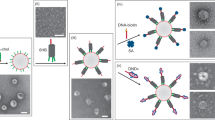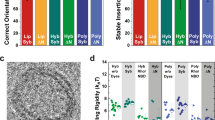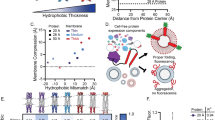Abstract
In biology, lipids are well known for their ability to assemble into spherical vesicles1. Proteins, in particular virus capsids, can also form regular vesicle-like structures, where the precise folding and stable conformations of many identical subunits directs their self-assembly2. Functionality present on these subunits also controls their disassembly within the cellular environment, for example, in response to a pH change3. Here, we report the preparation of diblock copolypeptides that self-assemble into spherical vesicular assemblies whose size and structure are dictated primarily by the ordered conformations of the polymer segments, in a manner similar to viral capsid assembly. Furthermore, functionality was incorporated into these molecules to render them susceptible to environmental stimuli, which is desirable for drug-delivery applications. The control of assembly and function exhibited in these systems is a significant advance towards the synthesis of materials that can mimic the precise three-dimensional assembly found in proteins.
This is a preview of subscription content, access via your institution
Access options
Subscribe to this journal
Receive 12 print issues and online access
$259.00 per year
only $21.58 per issue
Buy this article
- Purchase on Springer Link
- Instant access to full article PDF
Prices may be subject to local taxes which are calculated during checkout



Similar content being viewed by others
References
New, R.R.C. Liposomes: A Practical Approach (Oxford Univ. Press, New York, 1997).
Caspar, D.L.D. & Klug, A. Physical principles in construction of regular viruses. Cold Spring Harbor Symp. Quant. Biol. 27, 1–24 (1962).
Carr, C.M. & Kim, P.S. A spring-loaded mechanism for the conformational change of influenza hemagglutinin. Cell 73, 823–832 (1993).
Deming, T.J. Facile synthesis of block copolypeptides of defined architecture. Nature 390, 386–389 (1997).
Deming, T.J. Cobalt and iron initiators for the controlled polymerization of α-amino acid-N-carboxyanhydrides. Macromolecules 32, 4500–4502 (1999).
Deming, T.J. & Curtin, S.A. Chain initiation efficiency in cobalt- and nickel-mediated polypeptide synthesis. J. Am. Chem. Soc. 122, 5710–5717 (2000).
Deming, T.J. Living polymerization of α-amino acid-N-carboxyanhydrides. J. Polym. Sci. Polym. Chem. Ed. 38, 3011–3018 (2000).
Nowak, A.P. et al. Rapidly recovering hydrogel scaffolds from self-assembling diblock copolypeptide amphiphiles. Nature 417, 424–428 (2002).
Cha, J.N., Stucky, G.D., Morse, D.E. & Deming, T.J. Biomimetic synthesis of ordered silica structures mediated by block copolypeptides. Nature 403, 289–292 (2000).
Cornelissen, J.J.L.M., Fischer, M., Sommerdijk, N.A.J.M. & Nolte, R.J.M. Helical superstructures from charged poly(styrene)-poly(isocyanodipeptide) block copolymers. Science 280, 1427–1430 (1998).
Stupp, S.I. et al. Supramolecular materials: Self-organized nanostructures. Science 276, 384–389 (1997).
Lee, M., Cho, B.-K. & Zin, W.-C. Supramolecular structures from rod-coil block copolymers. Chem. Rev. 101, 3869–3892 (2001).
Chécot, F., Lecommandoux, S., Gnanou, Y. & Klok, H.-A. Water-Soluble stimuli-responsive vesicles from peptide-based diblock copolymers. Angew. Chem. Intl Edn 41, 1340–1343 (2001).
Chécot, F., Lecommandoux, S., Klok, H.-A. & Gnanou, Y. From supramolecular polymersomes to stimuli-responsive nanocapsules based on poly(diene-b-peptide) diblock copolymers. Eur. Phys. J. E 10, 25–35 (2003).
Schlaad, H. & Antonetti, M. Block Copolymers with amino acid sequences: molecular chimeras of polypeptides and synthetic polymers. Eur. Phys. J. E 10, 17–23 (2003).
Yu, M., Nowak, A.P., Pochan, D.P. & Deming, T.J. Methylated mono- and diethyleneglycol functionalized polylysines: nonionic, α-helical, water-soluble polypeptides. J. Am. Chem. Soc. 121, 12210–12211 (1999).
Nagasawa, M. & Holtzer, A. The helix-coil transition in solutions of polyglutamic acid. J. Am. Chem Soc. 86, 538–543 (1964).
Epand, R.F. & Scheraga, H.A. The helix-coil transition of poly-L-lysine in methanol-water solvent mixtures. Biopolymers 6, 1383–1386 (1968).
Sela, M. & Katchalski, E. Biological properties of poly α-amino acids. Adv. Protein Chem. 14, 391–478 (1959).
Discher, B.M., Hammer, D.A., Bates, F.S. & Discher, D.E. Polymer vesicles in various media. Curr. Opin. Coll. Interface. Sci. 5, 125–131 (2000).
Fasman, G.D. Prediction of Protein Structure and the Principles of Protein Conformation (Plenum, New York, 1989).
Discher, B.M. et al. Polymersomes: Tough vesicles made from diblock copolymers. Science 284, 1143–1146 (1999).
Yu, K. & Eisenberg, A. Bilayer morphologies of self-assembled crew-cut aggregates of amphiphilic ps-b-peo diblock copolymers in solution. Macromolecules 31, 3509–3518 (1998).
Bamford, C.H., Elliot, A. & Hanby, W.E. Synthetic Polypeptides (Academic, New York, 1956).
Katchalski, E. & Sela, M. Synthesis and chemical properties of poly-α-amino acids. Adv. Protein Chem. 13, 243–492 (1958).
Discher, D.E. & Eisenberg, A. Polymer vesicles. Science 297, 967–973 (2002).
Zalipsky, S. Chemistry of polyethylene glycol conjugates with biologically active molecules. Adv. Drug Delivery Rev. 16, 157–182 (1995).
Grynkiewicz, G., Poenie, M. & Tsien, R.Y. A new generation of Ca2+ indicators with greatly improved fluorescence properties. J. Biol. Chem. 260, 3440–3450 (1985).
Acknowledgements
The authors thank Kelly D. Hales (University of Delaware) for assistance with the DLS measurements. This work was supported by grants from the National Science Foundation (Award No. CTS-9986347 and CTS-0103516), the Arnold and Mabel Beckman Foundation, and partially supported by the MRSEC program of the National Science Foundation under award No. DMR-0080034. This work used SANS facilities supported in part by the National Science Foundation under Agreement No. DMR-9986442, the National Institute of Standards and Technology, and the US Department of Commerce.
Author information
Authors and Affiliations
Corresponding author
Ethics declarations
Competing interests
The authors declare no competing financial interests.
Supplementary information
Rights and permissions
About this article
Cite this article
Bellomo, E., Wyrsta, M., Pakstis, L. et al. Stimuli-responsive polypeptide vesicles by conformation-specific assembly. Nature Mater 3, 244–248 (2004). https://doi.org/10.1038/nmat1093
Received:
Accepted:
Published:
Issue Date:
DOI: https://doi.org/10.1038/nmat1093
This article is cited by
-
Intrinsically fluorescent polyureas toward conformation-assisted metamorphosis, discoloration and intracellular drug delivery
Nature Communications (2022)
-
Helical Nonfouling Polypeptides for Biomedical Applications
Chinese Journal of Polymer Science (2022)
-
Helical supramolecular nanorods via sequential meticulous tailoring of noncovalent interaction and light irradiation
Science China Chemistry (2022)
-
Synthesis of pH-responsive polyimide hydrogel from bioderived amino acid
Polymer Journal (2021)
-
Bidimensional lamellar assembly by coordination of peptidic homopolymers to platinum nanoparticles
Nature Communications (2020)



